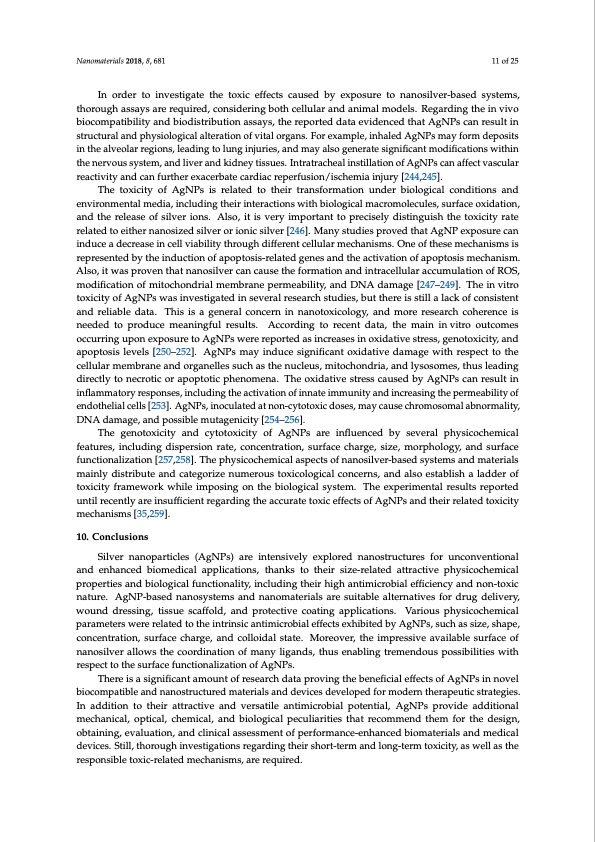
PDF Publication Title:
Text from PDF Page: 011
Nanomaterials 2018, 8, 681 11 of 25 In order to investigate the toxic effects caused by exposure to nanosilver-based systems, thorough assays are required, considering both cellular and animal models. Regarding the in vivo biocompatibility and biodistribution assays, the reported data evidenced that AgNPs can result in structural and physiological alteration of vital organs. For example, inhaled AgNPs may form deposits in the alveolar regions, leading to lung injuries, and may also generate significant modifications within the nervous system, and liver and kidney tissues. Intratracheal instillation of AgNPs can affect vascular reactivity and can further exacerbate cardiac reperfusion/ischemia injury [244,245]. The toxicity of AgNPs is related to their transformation under biological conditions and environmental media, including their interactions with biological macromolecules, surface oxidation, and the release of silver ions. Also, it is very important to precisely distinguish the toxicity rate related to either nanosized silver or ionic silver [246]. Many studies proved that AgNP exposure can induce a decrease in cell viability through different cellular mechanisms. One of these mechanisms is represented by the induction of apoptosis-related genes and the activation of apoptosis mechanism. Also, it was proven that nanosilver can cause the formation and intracellular accumulation of ROS, modification of mitochondrial membrane permeability, and DNA damage [247–249]. The in vitro toxicity of AgNPs was investigated in several research studies, but there is still a lack of consistent and reliable data. This is a general concern in nanotoxicology, and more research coherence is needed to produce meaningful results. According to recent data, the main in vitro outcomes occurring upon exposure to AgNPs were reported as increases in oxidative stress, genotoxicity, and apoptosis levels [250–252]. AgNPs may induce significant oxidative damage with respect to the cellular membrane and organelles such as the nucleus, mitochondria, and lysosomes, thus leading directly to necrotic or apoptotic phenomena. The oxidative stress caused by AgNPs can result in inflammatory responses, including the activation of innate immunity and increasing the permeability of endothelial cells [253]. AgNPs, inoculated at non-cytotoxic doses, may cause chromosomal abnormality, DNA damage, and possible mutagenicity [254–256]. The genotoxicity and cytotoxicity of AgNPs are influenced by several physicochemical features, including dispersion rate, concentration, surface charge, size, morphology, and surface functionalization [257,258]. The physicochemical aspects of nanosilver-based systems and materials mainly distribute and categorize numerous toxicological concerns, and also establish a ladder of toxicity framework while imposing on the biological system. The experimental results reported until recently are insufficient regarding the accurate toxic effects of AgNPs and their related toxicity mechanisms [35,259]. 10. Conclusions Silver nanoparticles (AgNPs) are intensively explored nanostructures for unconventional and enhanced biomedical applications, thanks to their size-related attractive physicochemical properties and biological functionality, including their high antimicrobial efficiency and non-toxic nature. AgNP-based nanosystems and nanomaterials are suitable alternatives for drug delivery, wound dressing, tissue scaffold, and protective coating applications. Various physicochemical parameters were related to the intrinsic antimicrobial effects exhibited by AgNPs, such as size, shape, concentration, surface charge, and colloidal state. Moreover, the impressive available surface of nanosilver allows the coordination of many ligands, thus enabling tremendous possibilities with respect to the surface functionalization of AgNPs. There is a significant amount of research data proving the beneficial effects of AgNPs in novel biocompatible and nanostructured materials and devices developed for modern therapeutic strategies. In addition to their attractive and versatile antimicrobial potential, AgNPs provide additional mechanical, optical, chemical, and biological peculiarities that recommend them for the design, obtaining, evaluation, and clinical assessment of performance-enhanced biomaterials and medical devices. Still, thorough investigations regarding their short-term and long-term toxicity, as well as the responsible toxic-related mechanisms, are required.PDF Image | Biomedical Applications of Silver Nanoparticles

PDF Search Title:
Biomedical Applications of Silver NanoparticlesOriginal File Name Searched:
nanomaterials-08-00681-v2.pdfDIY PDF Search: Google It | Yahoo | Bing
Turbine and System Plans CAD CAM: Special for this month, any plans are $10,000 for complete Cad/Cam blueprints. License is for one build. Try before you buy a production license. More Info
Waste Heat Power Technology: Organic Rankine Cycle uses waste heat to make electricity, shaft horsepower and cooling. More Info
All Turbine and System Products: Infinity Turbine ORD systems, turbine generator sets, build plans and more to use your waste heat from 30C to 100C. More Info
CO2 Phase Change Demonstrator: CO2 goes supercritical at 30 C. This is a experimental platform which you can use to demonstrate phase change with low heat. Includes integration area for small CO2 turbine, static generator, and more. This can also be used for a GTL Gas to Liquids experimental platform. More Info
Introducing the Infinity Turbine Products Infinity Turbine develops and builds systems for making power from waste heat. It also is working on innovative strategies for storing, making, and deploying energy. More Info
Need Strategy? Use our Consulting and analyst services Infinity Turbine LLC is pleased to announce its consulting and analyst services. We have worked in the renewable energy industry as a researcher, developing sales and markets, along with may inventions and innovations. More Info
Made in USA with Global Energy Millennial Web Engine These pages were made with the Global Energy Web PDF Engine using Filemaker (Claris) software.
Infinity Turbine Developing Spinning Disc Reactor SDR or Spinning Disc Reactors reduce processing time for liquid production of Silver Nanoparticles.
| CONTACT TEL: 608-238-6001 Email: greg@infinityturbine.com | RSS | AMP |